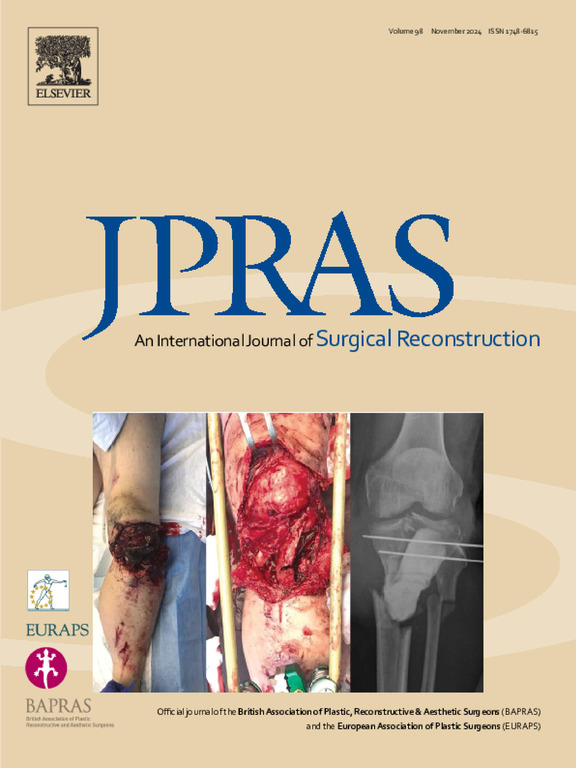氨甲环酸对面部美容手术术后并发症和出血的影响:系统回顾和荟萃分析
IF 2
3区 医学
Q2 SURGERY
Journal of Plastic Reconstructive and Aesthetic Surgery
Pub Date : 2025-05-20
DOI:10.1016/j.bjps.2025.05.024
引用次数: 0
摘要
氨甲环酸(TXA)是一种合成抗纤溶药物,最初用于止血,现在广泛用于美容和重建手术。它在面部美容过程中的应用旨在减少出血、肿胀和瘀伤。本系统综述评估了TXA对面部美容手术术后结果的影响,重点是出血量、手术时间、水肿和瘀斑。方法本综述遵循系统评价和荟萃分析指南的首选报告项目,以及2004年至2024年间发表的随机对照试验、队列研究和病例对照研究的综合数据。符合条件的研究检查了TXA在面部美容手术(如鼻整形、除皱和眼睑整形)中的应用。结果包括术中出血、手术时间、术后水肿、瘀斑和患者满意度。在PubMed、Embase、Cochrane Library和谷歌Scholar数据库中进行了全面的搜索。结果共纳入22项研究,共9005例患者。TXA可显著减少出血量、术后水肿和瘀斑。平均手术时间为122.17 (SD: 34.44) min,平均失血量为86.63 (SD: 56.93) cc。TXA的使用持续减少排液量和术后并发症,特别是在鼻整形和除皱手术中。各种给药途径(静脉、局部或局部浸润)均未出现明显的全身并发症。TXA联合局麻药可提高止血和麻醉效果。结论txa是一种有效的面部美容手术辅助药物,可减少术中出血,缩短手术时间,减少术后水肿、瘀斑等后遗症。需要进一步的研究来建立标准化的剂量和客观的结果分级。TXA的安全性和有效性表明它应该成为面部美容手术的标准做法。本文章由计算机程序翻译,如有差异,请以英文原文为准。
Impact of tranexamic acid on postoperative complications and bleeding in facial aesthetic surgery: A systematic review and meta-analysis
Background
Tranexamic acid (TXA) is a synthetic antifibrinolytic agent originally developed for hemostasis, which is now widely used in aesthetic and reconstructive surgery. Its application in facial cosmetic procedures is aimed at reducing bleeding, swelling, and bruising. This systematic review assesses the impact of TXA on postoperative outcomes in facial cosmetic surgery, focusing on blood loss, surgical time, edema, and ecchymosis.
Methods
This review followed the preferred reporting items for systematic reviews and meta-analyses guidelines and synthesized data from randomized controlled trials, cohort studies, and case-control studies published between 2004 and 2024. Eligible studies examined TXA in aesthetic facial surgeries (e.g., rhinoplasty, rhytidectomy, and blepharoplasty). Outcomes included intraoperative bleeding, surgical time, postoperative edema, ecchymosis, and patient satisfaction. A comprehensive search was conducted across the PubMed, Embase, Cochrane Library, and Google Scholar databases.
Results
Twenty-two studies involving 9005 patients were included. TXA significantly reduced blood loss, postoperative edema, and ecchymosis. The average surgical time was 122.17 (SD: 34.44) min, with mean blood loss of 86.63 (SD: 56.93) cc. TXA use consistently decreased drain output and postoperative complications, particularly in rhinoplasty and rhytidectomy. Various administration routes (intravenous, topical, or local infiltration) showed no significant systemic complications. Combining TXA with local anesthetics improved hemostatic and anesthetic efficacy.
Conclusion
TXA is an effective adjunct in facial cosmetic surgery that reduces intraoperative bleeding, surgical time, and postoperative sequelae such as edema and ecchymosis. Further studies are needed to establish standardized dosing and objective outcome grading. TXA demonstrated safety and efficacy indicating that it should become a standard practice in facial aesthetic procedures.
求助全文
通过发布文献求助,成功后即可免费获取论文全文。
去求助
来源期刊
CiteScore
3.10
自引率
11.10%
发文量
578
审稿时长
3.5 months
期刊介绍:
JPRAS An International Journal of Surgical Reconstruction is one of the world''s leading international journals, covering all the reconstructive and aesthetic aspects of plastic surgery.
The journal presents the latest surgical procedures with audit and outcome studies of new and established techniques in plastic surgery including: cleft lip and palate and other heads and neck surgery, hand surgery, lower limb trauma, burns, skin cancer, breast surgery and aesthetic surgery.

 求助内容:
求助内容: 应助结果提醒方式:
应助结果提醒方式:


